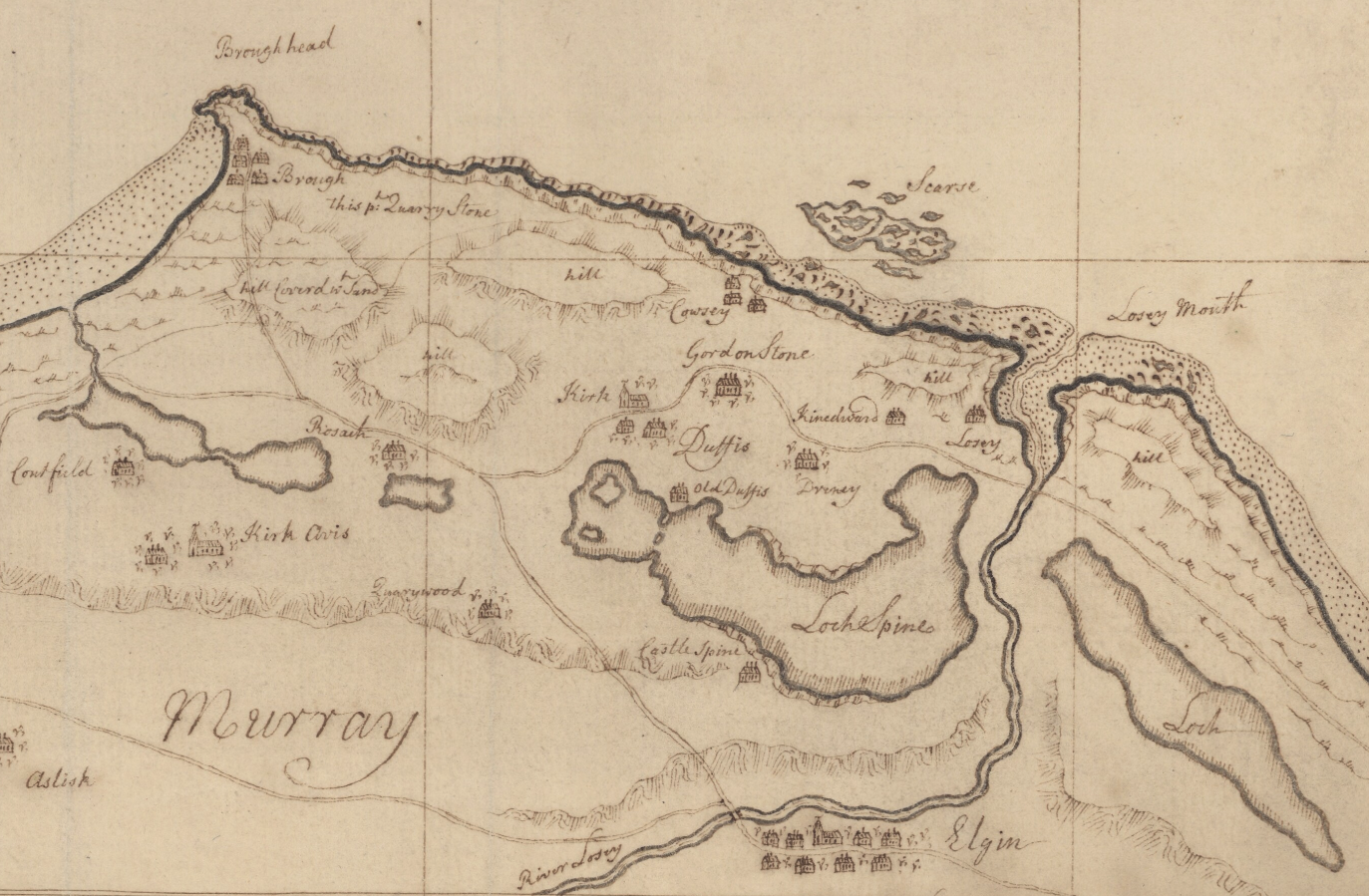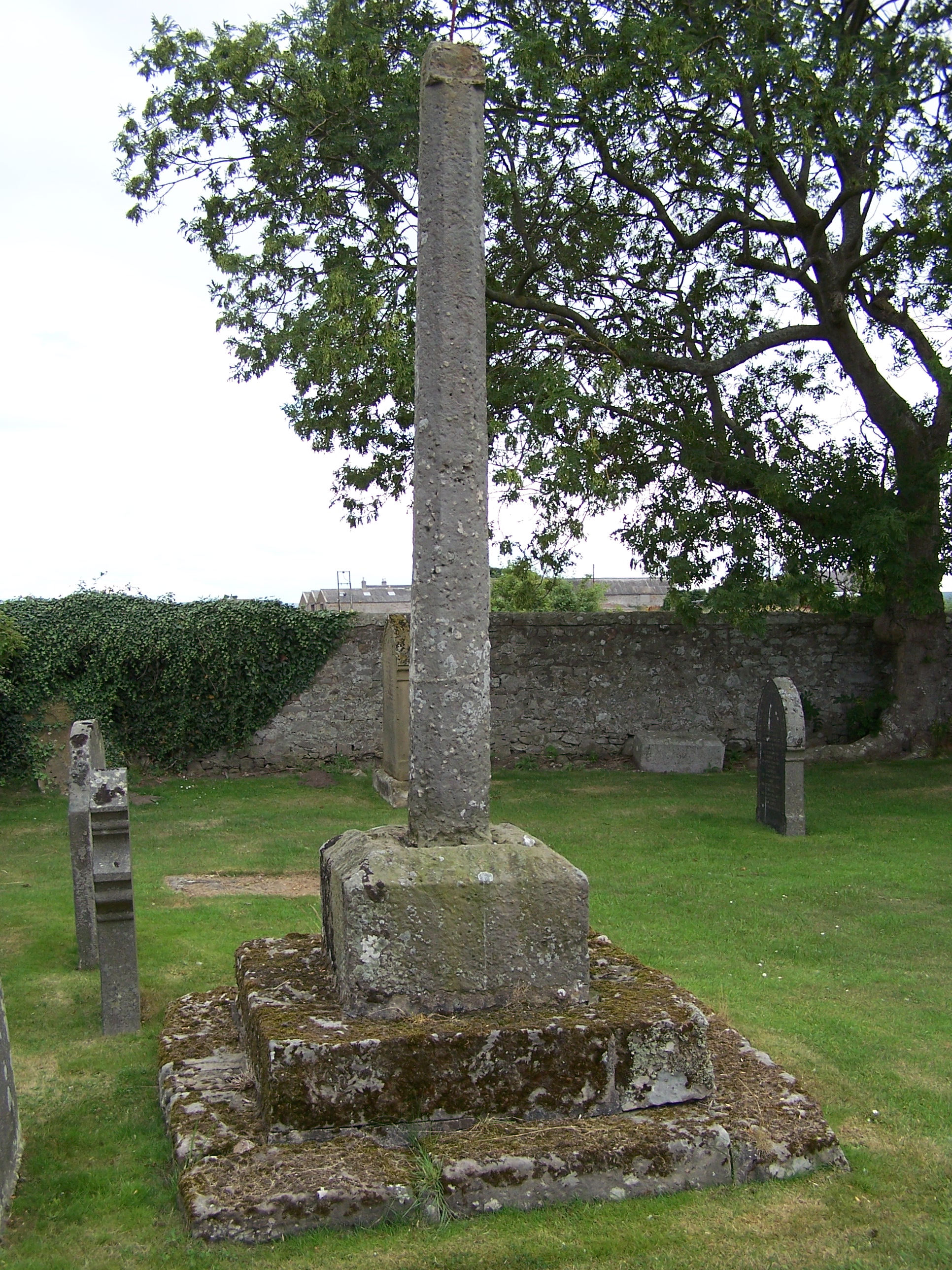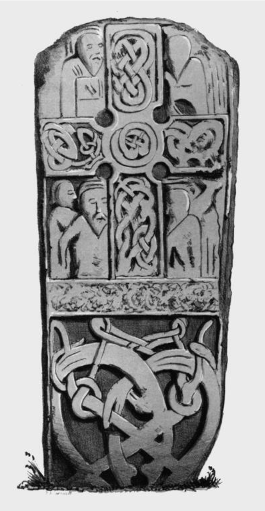|
Spynie
Spynie was a seaport, burgh and ancient parish in Moray, Scotland, that survives as a small hamlet and civil parish. It is the location of the ruins of Spynie Palace, which was the principal residence of the Bishops of Moray between the 12th and 17th centuries, and the churchyard of Holy Trinity Church, Spynie, which served as the cathedral of the Diocese of Moray between 1207 and 1224. History Large deposits of oyster and cockle shells in the area provide evidence of human habitation going back to the neolithic period, and artefacts from Bronze Age occupation, including axes, pottery and shell deposits have been found on the site of the later settlement. Spynie developed as a seaport on the south shore of Loch Spynie, a much larger body of water in the medieval period than the present day, and one that was open to the sea until the late 15th century. Holy Trinity Church was in existence by the 12th century and possibly earlier and was, alongside Birnie and Kinneddar, one of t ... [...More Info...] [...Related Items...] OR: [Wikipedia] [Google] [Baidu] |
Spynie Palace
Spynie Palace, also known as Spynie Castle, was the fortified seat of the Bishops of Moray for about 500 years in Spynie, Moray, Scotland. The founding of the palace dates back to the late 12th century. It is situated about 500 m from the location of the first officially settled Cathedral Church of the Diocese of Moray, Holy Trinity Church in present-day Spynie Churchyard. For most of its occupied history, the castle was not described as a ''palace'' — this term first appeared in the Registry of Moray in a writ of 1524. Background The beginnings of the Bishopric of Moray are unclear. The first mention of a bishop was Gregoir whose name appeared on several royal charters in the 1120s. The early bishops of Moray had no fixed abode but moved between houses at Birnie, Kinneddar and Spynie. In 1172, King William I, the Lion, made grants to the church of the Holy Trinity of the Bishopric of Moray and to Bishop Simon de Tosny. Formal permission for the permanent move to Spynie w ... [...More Info...] [...Related Items...] OR: [Wikipedia] [Google] [Baidu] |
Spynie Palace And Loch From Spynie Kirkyard - Geograph
Spynie was a seaport, burgh and ancient parish in Moray, Scotland, that survives as a small hamlet and civil parish. It is the location of the ruins of Spynie Palace, which was the principal residence of the Bishops of Moray between the 12th and 17th centuries, and the churchyard of Holy Trinity Church, Spynie, which served as the cathedral of the Diocese of Moray between 1207 and 1224. History Large deposits of oyster and cockle shells in the area provide evidence of human habitation going back to the neolithic period, and artefacts from Bronze Age occupation, including axes, pottery and shell deposits have been found on the site of the later settlement. Spynie developed as a seaport on the south shore of Loch Spynie, a much larger body of water in the medieval period than the present day, and one that was open to the sea until the late 15th century. Holy Trinity Church was in existence by the 12th century and possibly earlier and was, alongside Birnie and Kinneddar, one of th ... [...More Info...] [...Related Items...] OR: [Wikipedia] [Google] [Baidu] |
Holy Trinity Church, Spynie
Holy Trinity Church, Spynie was until 1735 the parish church of Spynie, Moray in north-east Scotland, and served as the cathedral of the Diocese of Moray between 1207 and 1224. No trace of the church can now be seen, but its graveyard remains near Spynie Palace, and its site is occupied by two burial vaults, with a cross marking the location of the church's eastern end. The graveyard is the burial place of former British Prime Minister Ramsay MacDonald. History The church at Spynie dates back to the 12th century, and possibly earlier. The early Bishops of Moray had no fixed cathedral, moving between the churches of Spynie, Birnie and Kinneddar. Between 1172 and 1174 King William the Lion agreed with Bishop Simon de Tosny to grant all of his teinds from the Diocese of Moray "to the church of the Holy Trinity of the bishopric of Moray and to Lord Simon, Bishop of Moray". Bishop Simon reached a similar agreement with Freskin of Duffus Castle regarding the woods and mosses o ... [...More Info...] [...Related Items...] OR: [Wikipedia] [Google] [Baidu] |
Loch Spynie
Loch Spynie is a small loch located between the towns of Elgin and Lossiemouth in Moray, Scotland. Close to Spynie Palace, the ancient home of the bishops of Moray, it is an important wildlife habitat which is protected as a Ramsar Site. History Loch Spynie is a remnant of a great wetland that stretched from the western shore of the current loch to the mouth of the River Lossie and, at that time, many of the settlements along the Moray coast were actually islands in the Moray Firth. The connections this area had to the sea silted up over the centuries but the Laich of Moray was still navigable in the middle ages. In the mid 19th century the Spynie Canal was constructed by Thomas Telford to drain the Laich of Moray for farmland. Artificial shores were built on the western and northern sides of the loch which was kept for wildfowling and fishing. Wildfowling has stopped altogether since 1981 and the amount of angling has been negligible since that year too. In 1679 Janet Grant ... [...More Info...] [...Related Items...] OR: [Wikipedia] [Google] [Baidu] |
Kinneddar
Kinneddar is a small settlement on the outskirts of Lossiemouth in Moray, Scotland, near the main entrance to RAF Lossiemouth. Long predating the modern town of Lossiemouth, Kinneddar was a major monastic centre for the Pictish kingdom of Fortriu from the 6th or 7th centuries, and the source of the important collection of Pictish stones called the Drainie Carved Stones. The Kirk of Kinneddar was the cathedral of the Diocese of Moray between 1187 and 1208, and remained an important centre of diocesan administration and residence of the Bishop of Moray through the 13th and 14th centuries. Today little remains of the site except the old kirkyard, including the former parish cross. The Bishop's Palace at Kinneddar went out of use in the 15th century when the barony of Kinneddar was combined into the larger barony of Spynie, with stone from the palace being used to build Spynie Palace. The Kirk of Kinneddar became redundant when its parish was combined with that of Ogstoun to form ... [...More Info...] [...Related Items...] OR: [Wikipedia] [Google] [Baidu] |
Diocese Of Moray
The Diocese of Moray was one of the most important of the medieval dioceses of the Roman Catholic Church in Scotland. Its territory was in central northern Scotland. History It was founded in the early years of the 12th century by David I of Scotland under its first bishop, Gregoir. It was suppressed in 1638 and never revived as a titular see. Bishops of Moray Bishop Bricius organised the constitution of the church, but it was Bishop Andreas who increased the number of dignitaries and prebend canons and was responsible for gaining large grants of land from his kinsmen, the powerful de Moravia lords, as well as from the king. In the year of his death, Andreas changed the cathedral's constitution to mirror that of Salisbury. Other bishops made a lasting impact on the diocese; probably the most important of these was Alexander Bur (1362–1397), who championed the right of the Moray church to retain its property against a ruthless magnate, Alexander Stewart, Earl of Buch ... [...More Info...] [...Related Items...] OR: [Wikipedia] [Google] [Baidu] |
Bishop Of Moray
The Bishop of Moray or Bishop of Elgin was the ecclesiastical head of the Diocese of Moray in northern Scotland, one of Scotland's 13 medieval bishoprics. If the foundation charter of the monastery at Scone is reliable, then the Bishopric of Moray was in existence as early as the reign of King Alexander I of Scotland (1107–1124), but was certainly in existence by 1127, when one Gregoir ("Gregorius") is mentioned as "Bishop of Moray" in a charter of king David I of Scotland. The bishopric had its seat ( la, Cathedra) at Elgin and Elgin Cathedral, but was severally at Birnie, Kinneddar and as late as Bishop Andreas de Moravia at Spynie, where the bishops continued to maintain a palace. The Bishopric's links with Rome ceased to exist after the Scottish Reformation, but continued, saving temporary abolition between 1638 and 1661, under the episcopal Church of Scotland The Church of Scotland ( sco, The Kirk o Scotland; gd, Eaglais na h-Alba) is the national church in S ... [...More Info...] [...Related Items...] OR: [Wikipedia] [Google] [Baidu] |
Alexander Bur
Alexander Bur (died 1397) was a 14th-century Scottish cleric. It is highly possible that Bur came from somewhere in or around Aberdeenshire, although that is not certain and is only based on the knowledge that Aberdeenshire is where other people bearing his surname come from in this period. He entered the service of King David II of Scotland sometime after 1343, perhaps as a member of David's exiled court at Château Gaillard. Although Alexander by this point in time already held prebends in both the bishopric of Aberdeen and the bishopric of Dunkeld (where he also held a canonry), on that date King David petitioned Pope Clement VI for another canonry in the bishopric of Moray. Alexander had become a royal clerk and had obtained a Licentiate in Canon Law by 1350. By the latter date, upon the death of Adam Penny (or Adam Parry), Archdeacon of Moray, Alexander himself became Archdeacon. In the autumn of this year King David II made an expedition into the north, apparently to esca ... [...More Info...] [...Related Items...] OR: [Wikipedia] [Google] [Baidu] |
Elgin, Moray
Elgin (; sco, Ailgin; gd, Eilginn, ) is a town (former cathedral city) and formerly a Royal Burgh in Moray, Scotland. It is the administrative and commercial centre for Moray. The town originated to the south of the River Lossie on the higher ground above the floodplain where the town of Birnie is. There, the church of Birnie Kirk was built in 1140 and serves the community to this day. Elgin is first documented in the Cartulary of Moray in 1190 AD. It was created a royal burgh in the 12th century by King David I of Scotland, and by that time had a castle on top of the present-day Lady Hill to the west of the town. The origin of the name Elgin is likely to be Celtic. It may derive from 'Aille' literally signifying beauty, but in topography a beautiful place or valley. Another possibility is 'ealg', meaning both 'Ireland' and 'worthy'. The termination 'gin' or 'in' are Celtic endings signifying little or diminutive forms, hence Elgin could mean beautiful place, worthy place or l ... [...More Info...] [...Related Items...] OR: [Wikipedia] [Google] [Baidu] |
John De Pilmuir
John de Pilmuir ''Pilmor, Pylmore(died 1362) was a 14th-century prelate based in Scotland. He was probably the son of Adam de Pilmuir, a Dundee burgess, and the brother of Richard de Pilmuir, Bishop of Dunkeld (1337/38–1345/47). Originally a canon of the diocese of Ross, on 30 March 1326, he was consecrated by Pope John XXII as Bishop of Moray at Avignon. The diocese of Moray had been reserved during the episcopate of David de Moravia, and this along with the lack of any record of an election in Moray makes it probable that Pilmuir was a direct appointment of the papacy. He had previously been the vicar in spirituals of Pierre Roger, Archbishop of Rouen, the future Pope Clement VI. As a bishop, Pilmuir was a frequent petitioner to the papacy. He completed the foundation of the Scots College in Paris, initiated by his predecessor in Moray David de Moravia. The college remain the responsibility of the Bishops of Moray until the Reformation. He died at episcopal residence of ... [...More Info...] [...Related Items...] OR: [Wikipedia] [Google] [Baidu] |
Leith
Leith (; gd, Lìte) is a port area in the north of the city of Edinburgh, Scotland, founded at the mouth of the Water of Leith. In 2021, it was ranked by ''Time Out'' as one of the top five neighbourhoods to live in the world. The earliest surviving historical references are in the royal charter authorising the construction of Holyrood Abbey in 1128 in which it is termed ''Inverlet'' (Inverleith). After centuries of control by Edinburgh, Leith was made a separate burgh in 1833 only to be merged into Edinburgh in 1920. Leith is located on the southern coast of the Firth of Forth and lies within the City of Edinburgh Council area; since 2007 it has formed one of 17 multi-member wards of the city. History As the major port serving Edinburgh, Leith has seen many significant events in Scottish history. First settlement The earliest evidence of settlement in Leith comes from several archaeological digs undertaken in The Shore area in the late 20th century. Amongst the f ... [...More Info...] [...Related Items...] OR: [Wikipedia] [Google] [Baidu] |
Burgh Of Barony
A burgh of barony was a type of Scottish town (burgh). Burghs of barony were distinct from royal burghs, as the title was granted to a landowner who, as a tenant-in-chief, held his estates directly from the crown. (In some cases, they might also be burghs of regality where the crown granted the leading noblemen judicial powers to try criminals for all offences except treason). They were created between 1450 and 1846, and conferred upon the landowner the right to hold weekly markets. Unlike royal burghs, they were not allowed to participate in foreign trade. In practice very few burghs of barony developed into market towns. Over 300 such burghs were created: the last was Ardrossan in 1846. From 1833 inhabitants of such burghs could form a police burgh governed by elected commissioners. In some cases the existing burgh continued to exist alongside the police burgh. Remaining burghs of barony were abolished in 1893 by the Burgh Police (Scotland) Act, 1892. Where a police burgh had ... [...More Info...] [...Related Items...] OR: [Wikipedia] [Google] [Baidu] |






